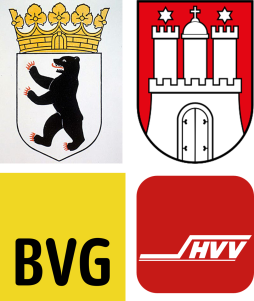
Berlin was founded in the 12th century, made capital of Prussia in 1701, served as the capital of Germany until 1945, was separated after World War II by walls, moats, barbed wire and bullets, and reunited in 1990. Since the 1990s, it has been a center of partying, party tourism and techno music, and increasingly a European political powerhouse.
Hamburg was founded in the 9th century and has grown its wealth over the last millennium as a key European harbor city, which has led to enormous diversity of people, spices, and well, the Reeperbahn.
Berlin’s population (~3.5 million) is about double Hamburg’s. Hamburg’s transit is generally recognized as the HVV, the regional transit association overseeing the 30 transit providers in the metro area. Berlin’s transit is mostly identified with the BVG, Berlin’s major transit provider of buses, trams, and the U-Bahn (subway). In 2014, the BVG saw 978 million boardings (not including the express or regional trains), HVV saw 738 million. Hamburg’s reputation is preppy and stuck up. Berlin is poor but sexy. So who has the most convincing transit ad? Are they indicative of the city culture?
The BVG hired the rap artist Kazim Akboga to make “Is mir egal” (I don’t care) with the message, “Only we love you, just like you are.” It’s a hilarious display of all the types of people you might run into on a subway in Berlin.
The HVV went with a much different tone, showing major destinations in Hamburg, and once the excitement is over and real life begins again, “Komm gut nach Hause!” (Get home well).
So which do you like better? By the way, the BVG also sells clothes and cell phone covers with the ugly spotty pattern in some of their U-Bahns. And they used to sell underwear with station names like Schöneberg (Beautiful Mountain), and Krumme Lanke (Crooked, uh, Lanke?)
February 25, 2016 at 4:10 am
The BVG add is more hip, and encapsulates the Berlin vibe better. But it also seems like a rip off of Edeka’s “Super Geil” ad in 2014.
I agree, many others in Germany think of people from HH as wealthy and insular, but they too have a creative and counter-cultural side (Sternschanze, St. Pauli, etc.). Either way, this ad doesn’t “feel” like either of those versions of Hamburg to me.
Nice job on the blog!
LikeLike